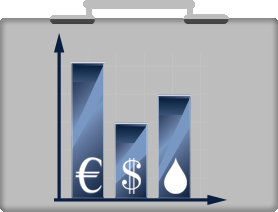- Innovations
- Articles on application of PCI
- New Trading Horizons
Portfolio Quoting Method - New Trading Strategies
Capabilities of the Method
Growing requirements for modern trading technologies and complex interrelations between financial assets drive the development of new approaches to analysis and trading. Such a new approach has been offered by trading technologies development company NetTradeX with the support of financial company IFC Markets. The joint product has been called “Portfolio Quoting Method (PQM)”.
Uniqueness
Unlike many of its competitors providing trading services with a “standard” group of financial instruments, these two companies succeeded in moving one step forward by not only implementing portfolio approach principles in a trading system for each customer, but also providing them an opportunity to create a unique personal financial instrument.
Essence of PQM Method
The essence of PQM Method is quite simple but yet very promising as the method has numerous spheres of application. It is a tool allowing to combine financial instruments, build portfolios by giving desired weights to assets, include not only long but also short positions, and what is more important, create a new financial unit, a product of comparing two groups of assets. It is assumed that all the assets have value expressed in USD, which makes the comparison easier.

Dollar
Euro
Oil
etc
The concept of portfolio trading method PQM is very similar to currency exchange rate, when the value of the base currency is expressed in units of the quoted currency. The difference is that in PQM method two portfolios stand for the base and the quoted currencies. The sum of the values of all assets adjusted for their corresponding weights in a portfolio gives an absolute dollar-denominated value for each portfolio. When comparing absolute values of two portfolios (base and quoted respectively), the method calculates a ratio, which is considered to be a “price” of the new composite structure (personal composite instrument – PCI) and can be interpreted as the value of the base portfolio, expressed in units of the quoted portfolio.
Advantages of the Method
So, what are the advantages of PQM method for a trader, looking for new opportunities to implement his/her trading ideas? What are the advantages for the asset managers trying to
find the optimal risk-return characteristics for his clients?
And finally, what are the advantages for an ordinary individual interested in
financial world and seeking to comprehend the complexity of interrelations of financial
assets?
Market participants, depending on their own analysis, allowed risks, commitment to
certain trading instruments and models, try to implement their trading strategies
using diverse software tools. In this regard, the flexibility to create
composite portfolios allows implementation of a great variety of trading ideas.
Flexibility of the Method
Applying PQM method helps transferring the idea into trading analytical system,
evaluate its efficiency in the past and apply variety of tools of technical analysis
for forecasting. In fact, the trader avoids limitations in the number of
available financial assets and comes to creating his/her own product - a trading idea,
expressed quantitatively in the trading analytical platform by creating composite
portfolios, which has its own price history and is ready to conduct a
large-scale analysis.
The value of such approach is, first of all, its flexibility which opens up new horizons for analysis and trading. Moreover it provides traders with an opportunity to create their own unique financial products. Therefore creativity and inventiveness of the trader come out on top and become one of the key factors of success. PQM method quickly converts two baskets of assets into an independent trading instrument with its own price and history, and as there are an infinite number of such baskets, infinite number of trading instruments and opportunities become available to the trader.
Studies show that the application of PQM method can be extremely useful for a wide
variety of investment strategies. Taking into consideration the infinite number of
options of composite instruments, just some of the many examples of its usage will be
provided below.
Portfolio Trading
PQM method of composite portfolio trading is closely tied to the principles of modern portfolio theory (for example, the mean-variance analysis of Harry Markowitz). The question of constructing a composite portfolio is directly related to the concepts of interrelationship of financial assets, risk diversification and management, search for the optimal portfolio structure. PQM method allows building portfolios of assets that best meet individual parameters of acceptable risk and required return of the investor. Moreover, the method allows including both long and short positions in the composite instrument - it depends on whether the asset is in the base or quoted portfolio.

Innovative Approach to the Study and Analysis of Financial Markets.
After creating a composite instrument, the price history will show a retrospective efficiency of the composite portfolio. The trader may choose to draw the price chart in absolute values of the composite portfolio, if a currency is selected as the only component of the quoted portfolio. Often the trader is interested in comparing the behavior of the portfolio relative to the whole market. In this case, for instance, a stock index may be selected as the quoted component of the composite portfolio, which will serve as a relative indicator of the strategy efficiency. If the strategy involves short sales of assets - they need to be placed in the quoted component of the composite portfolio, then the chart will fully comply with the concept of the method, reflecting the change in the value of the base portfolio, expressed in the number of units of the quoted portfolio.
Spread Trading
The strategy of spread trading is based on searching price convergences and divergences for similar instruments. Prices of financial instruments may react simultaneously on the same economic factor, but the speed and sensitivity of the reaction may differ. PQM method becomes indispensable to identify such patterns in deep histories. To implement the strategy, it is enough to build a chart that will display relative changes in prices, their speed and degree of sensitivity to common economic factors.
Trading around an average
The strategy is based on the search for a long-term stable relationship of assets, which is difficult to break with short-term fluctuations. In the short term, of course, the ratio deviates from the long-term stable level, but returns to it afterwards. PQM method is extremely effective for such type of trading, providing historical charts needed to determine longer-term mean-reverting levels and allowing the usage of technical analysis tools to open and close positions.
Instrument for hedging
Creating a composite portfolio can be designed not only to seek opportunities for speculative profits, but also for hedging risks. Having assumptions about the development of economic processes, portfolios with desired characteristics (sensitivity) to certain macroeconomic and fundamental factors can be built. Thus, if it is possible to reduce the sensitivity of the portfolio to a particular factor to a minimum, we can say that there is little or no influence of this factor on the value of the composite portfolio.
Whatever the chosen trading strategy is, PQM Method can be useful not only for traders. It gives considerable opportunities to analysts, economists and portfolio managers for understanding and analyzing the interrelations between separate assets and their combinations.
Previous articles
- The Exchange Rate and the Creation of New Financial Instruments on its Base
- Profiting in bear and bull oil markets
- Currency indices: unveiling central banks’ secrets
- Pair Trading with Inverse Spread: 3 Steps
- Portfolio Trading Method – Expanding the Range of Trading Instruments
- Portfolio Quoting Method – New Ways for Analysis of Financial Markets
